Using and Managing PPP
Andrew Sun
Page iii
Page iv
Using and Managing PPP
by Andrew Sun
Copyright © 1999 O'Reilly & Associates, Inc. All rights reserved.
Printed in the United States of America.
Published by O'Reilly & Associates, Inc., 101 Morris Street, Sebastopol, CA 95472.
Editor: Mike Loukides
Production Editor: Mary Anne Weeks Mayo
Production Services: Nancy Crumpton
Printing History:
March 1999: First Edition.
Nutshell Handbook, the Nutshell Handbook logo, and the O'Reilly logo are registered
trademarks of O'Reilly & Associates, Inc. The association between the image of a turtle and
the topic of using and managing PPP is a trademark of O'Reilly & Associates, Inc. Many of
�
the designations used by manufacturers and sellers to distinguish their products are claimed
as trademarks. Where those designations appear in this book, and O'Reilly & Associates, Inc.
was aware of a trademark claim, the designations have been printed in caps or initial caps.
While every precaution has been taken in the preparation of this book, the publisher assumes
no responsibility for errors or omissions, or for damages resulting from the use of the
information contained herein.
This book is printed on acid-free paper with 85% recycled content, 15% post-consumer
waste. O'Reilly & Associates is committed to using paper with the highest recycled content
available consistent with high quality.
ISBN: 1-56592-321-9 [7/99]break
Table of Contents
Preface
1. What Is PPP?
Early Remote Access and Networking
Serial Line Internet Protocol (SLIP)
Point-to-Point Protocol (PPP)
Open Systems Interconnect Model
What You Need to Know
2. Serial Interfaces and Modems
Serial Interfacing
Modems
3. How PPP Works
PPP Frame Format
PPP Connection States
Page v
ix
1
1
4
5
6
8
10
10
21
29
30
35
�
PPP Connection States
Link Control Protocol
Authentication in PPP
Network Control Protocol
Internet Protocol Control Protocol
Compressed Datagram
What PPP Doesn't Provide
4. TCP/IP
The Internet Protocol
Van Jacobson Compression
IP Addresses
Media Access Control Addresses
Routing
5. Selecting Hardware, Software, and Services
Selecting Serial Connections
PPP Hardware
PPP Software
6. Dial-out PPP Setup
PPP Sign-on Procedures
General PPP Setup Steps
Linux PPP-2.3
Solaris PPP
Page vi
35
37
48
53
54
58
59
60
61
66
69
75
78
84
84
88
94
103
104
106
107
117
�
Solaris PPP
Windows 3.1
Windows 98 (and 95)
Windows NT 4.0 Workstation
7. Dial-in PPP Setup
Dial-in PPP Architecture for Internet Access
Communication Servers
Linux PPP-2.3
Solaris PPP
Windows NT 4.0 Server
8. Network Architectures Incorporating PPP
Choosing Network Architectures
Proxy ARP
Split Subnet
Unnumbered
PPP in a Subnet
Multipoint PPP in a Subnet
9. Routing to PPP Connections
Routing Entries
Using Default Routes
Using Subnet Routes
Using Host-Specific Routes
Dynamic Routing Protocols
117
128
128
143
155
156
158
165
172
178
190
190
193
197
201
204
209
213
213
218
220
223
226
�
10. Domain Name System
Domain Name System Hierarchy
Using DNS
DNS Records for PPP
Setting up DNS Name Resolution
DNS Servers
11. Customizing and Tuning PPP
PPP Startup Options for Dial-in Servers
PPP Startup Options for Dial-out Servers
Adjustable LCP Options
Authentication Policy
Adjustable IPCP Options
Setting IP Addresses
Other Adjustable Settings
12. Authentication
Password Authentication Protocol
Challenge Handshake Authentication Protocol
Microsoft CHAP
Authenticating outside PPP
Call Back
Security Tokens
13 Private Networks
Page vii
232
233
235
236
238
243
245
245
248
250
257
260
264
268
269
270
274
278
280
283
285
289
�
13. Private Networks
Private Network Setup
Application Layer Proxies
Network Address Translation
14. Virtual Private Networking and Tunneling
Virtual Private Network Architectures
Tunneling Protocols
Redirecting Serial Input/Output
Setting up Outgoing PPP Tunnels
Setting up Incoming PPP Tunnels
Routing with Tunnels
Network Security
15. Troubleshooting
Troubleshooting Approaches
Trace and Activity Logs
Checking the Serial Connection
Checking Modems
Chat Script Problems
PPP Failures
Checking TCP/IP
16. What's New for PPP?
Communication Services
289
290
291
295
302
303
306
310
313
318
322
326
328
328
Page viii
329
330
343
348
354
371
383
384
�
Communication Services
Network Layer Protocols
PPP Extensions
Developments Relating to PPP
Product Obsolescence
A. PPP Assigned Numbers
B. Serial Interface Emulation
Index
384
387
388
394
396
397
410
421
Page ix
Preface
The Point-to-Point Protocol is a flexible and extensible communications protocol for use with
many types of point-to-point connections. PPP is unquestionably the most widely used
technology for connecting home computer users to the Internet. But it's not limited to
connecting remote users with telephone lines. PPP is also suitable for connections that are
part of the core infrastructure of the Internet and for private networks. PPP also supports
different and mixed types of data networks, not just those that use Internet technologies.
For the majority of the PPP end-user population, most major online service providers and
Internet service providers (ISPs) supply sign-on software for personal computers. This
software automatically sets up and configures dial-out PPP on behalf of users. Thus, users
can achieve the Internet online experience and still choose to remain completely oblivious to
PPP technology.
But what about the network administrator? What if you're responsible for designing and
implementating PPP communications? PPP is complex and depends on other serial
communications and networking technologies to be useful. To set up PPP, you may have to
sift through numerous reference materials about modems, serial interfaces, "how to"
documents, frequently asked questions (FAQs), and incomplete PPP software manuals that
raise more questions than answers. If you're in this situation, this book is for you.
This book collects most of the knowledge areas necessary for using and managing PPP. This
is a practical book, with specific examples for configuring PPP with common computer
software products, the Internet, and the ubiquitous telephone service. More importantly, the
book discusses both the hows and whys. This should give you the insight necessary to
implement PPP with equipment and communications technologies that aren't explicitly
covered here.break
�
Page x
Audience
This book is primarily intended for system and network administrators responsible for
implementing and managing PPP communications in their data network infrastructure. We
assume you have an understanding of data networks, especially the Internet. We expect
you're also familiar with computers and how to use them. Although we describe PPP with
Microsoft Windows NT/95/98, the focus is on Linux and Unix for the more complex PPP
configurations. Windows 95/98 just doesn't support more complex configurations. Windows
NT does support just about any configuration imaginable but doesn't provide enough
diagnostics to let you see what's happening "under the hood." Therefore, we used Linux and
Unix to demonstrate these features for pedagogical reasons. Once you understand what's
happening, you shouldn't have trouble with Windows NT. Thus, general familiarity with
Unix system administration is a plus.
The audience includes those PPP power users who access the Internet with Linux and other
platforms not common to mass-market users. You're also a power user, like it or not, if you
require a nontypical configuration. If you're in this category, consider yourself a system
administrator. Chapter 6, Dial-out PPP Setup, is perhaps the most useful for you.
This book is not intended for software developers, who should consult Internet standards for
PPP implementation specifics.
Organization
There are sixteen chapters and two appendixes in this book. However, groups of chapters
have special significance and purpose. These are:
Overview of technologies important to PPP
Chapters 1 through 4 include an overview of PPP and other critical technologies. In
particular, information about the Open Systems Interconnect model, RS-232 serial
interfacing, modems, and TCP/IP is included in these chapters.
Setting up PPP
Guidelines for selecting PPP products and supporting services, and details about setting
up both dial-in and dial-out PPP are included in Chapters 5 through 7.
Network architectures, routing, and name resolution
The PPP setup chapters focus only on the PPP connection in a specific network
architecture for common dial-in and dial-out. Chapters 8 through 10 discuss the role of
PPP connections as part of a greater network architecture. Network architectures are
particularly important when PPP connections arecontinue
responsible for network-to-network communications, rather than user-to-network
communications.
Page xi
�
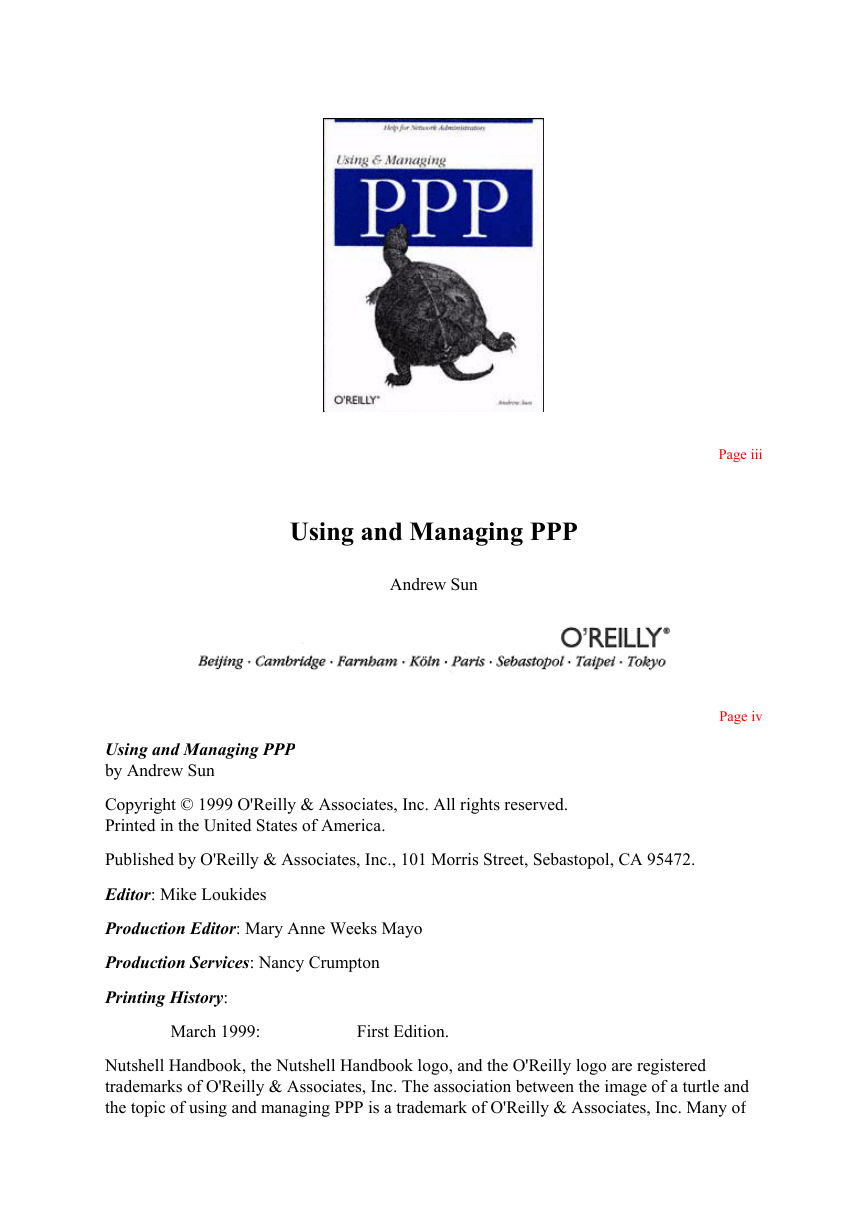
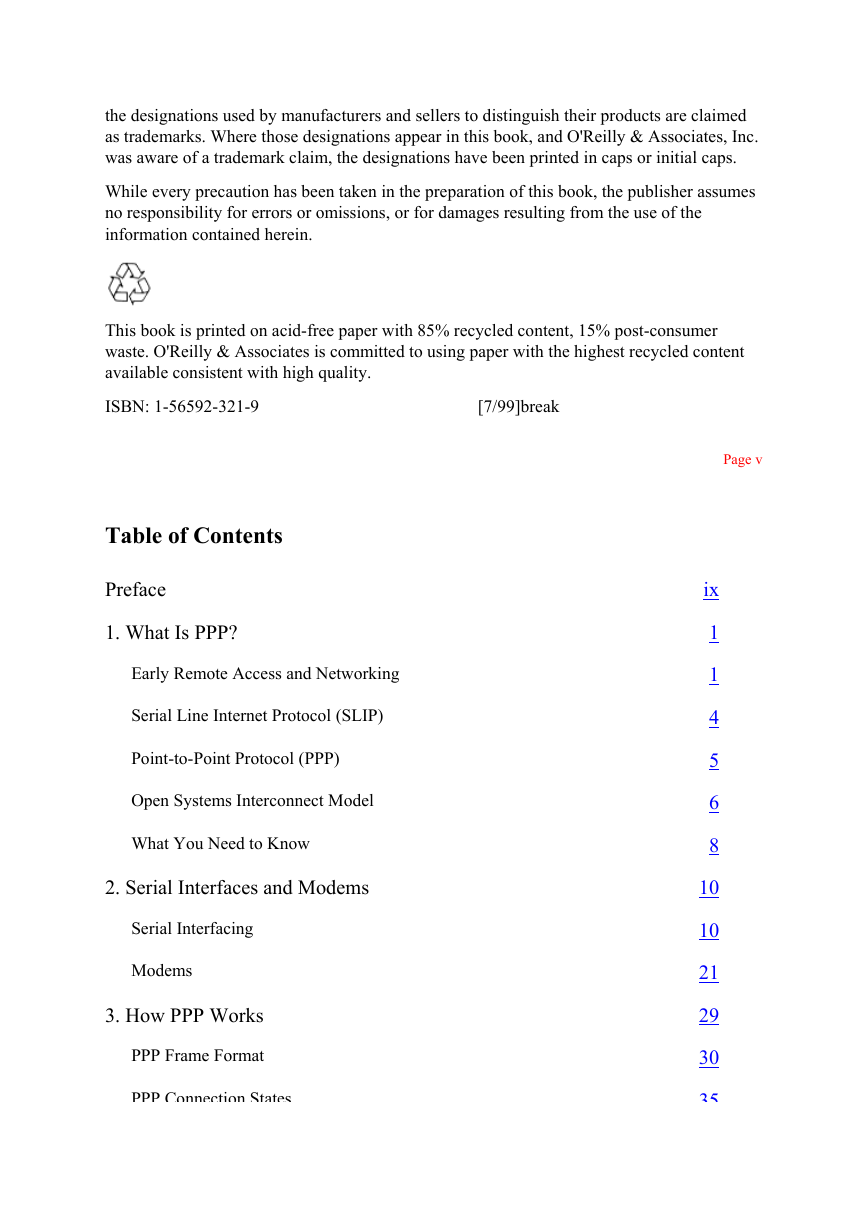
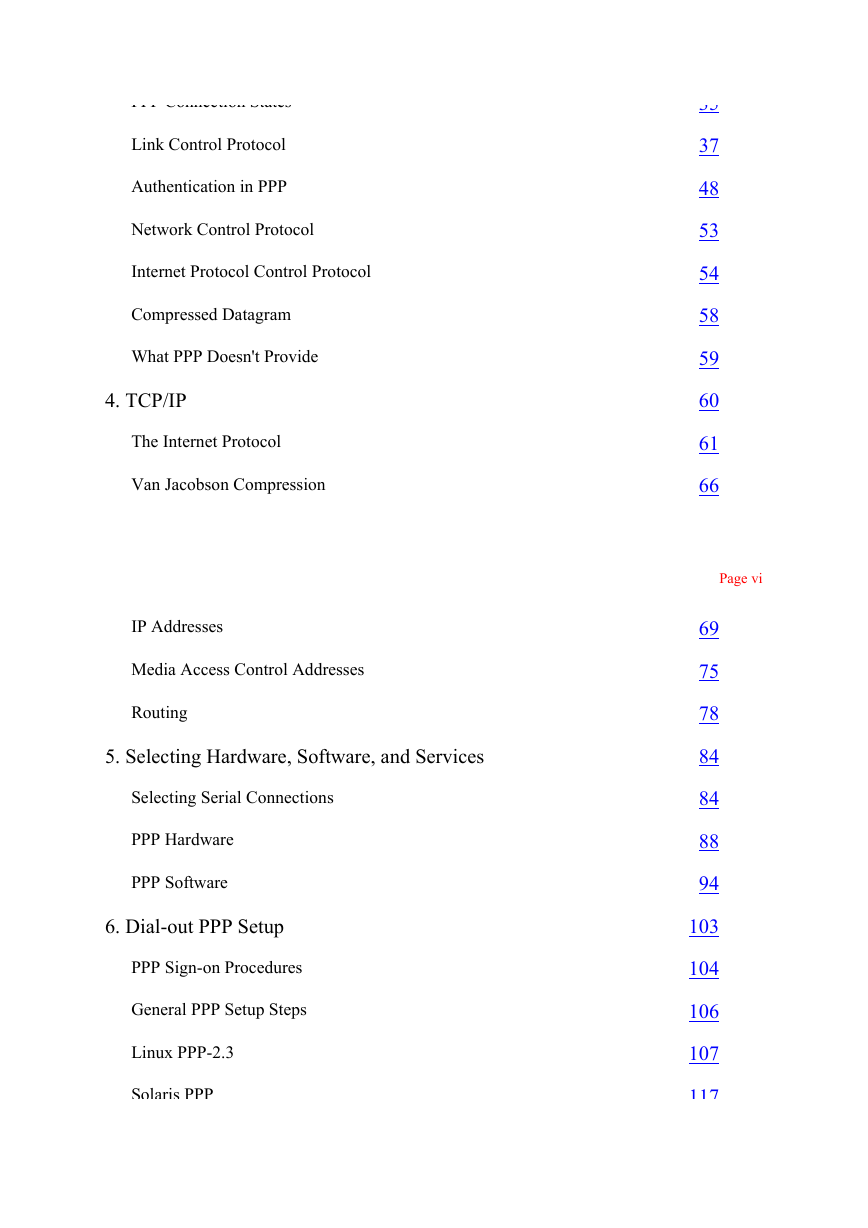
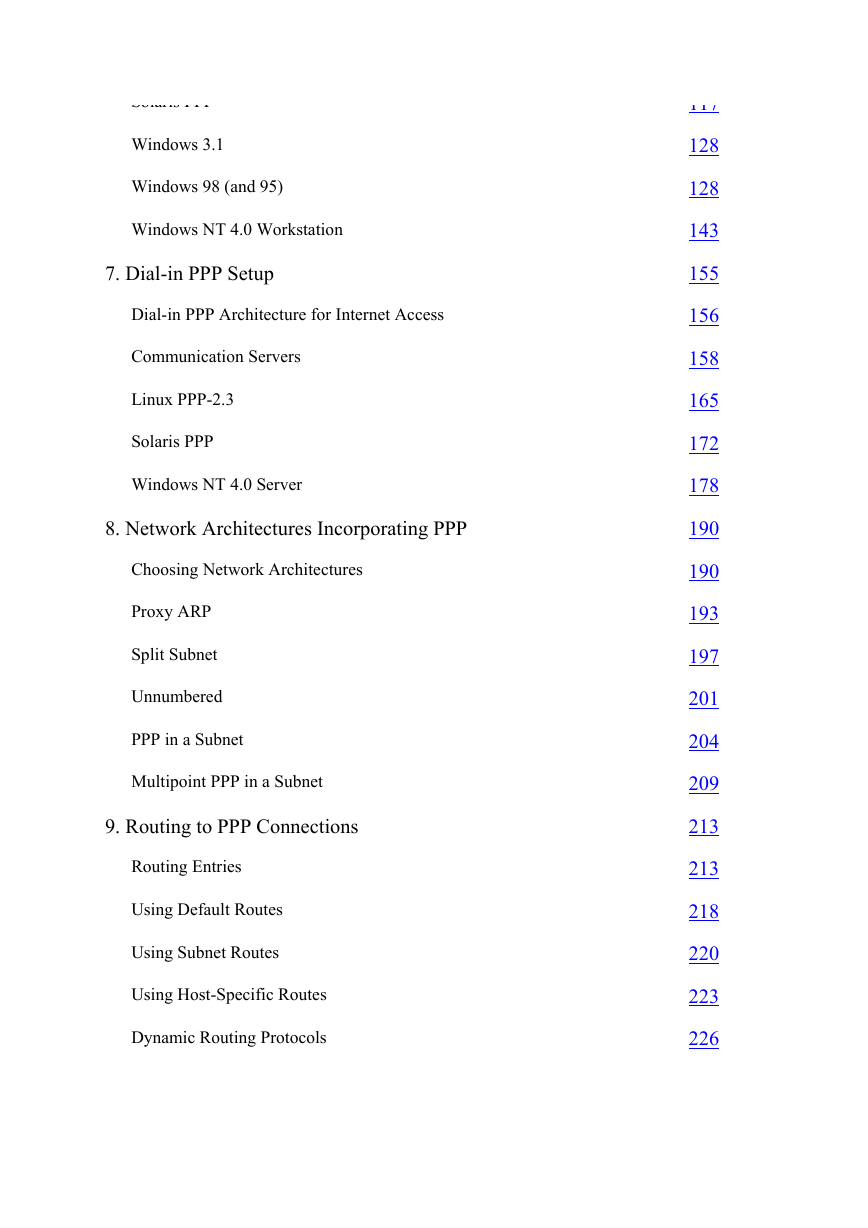

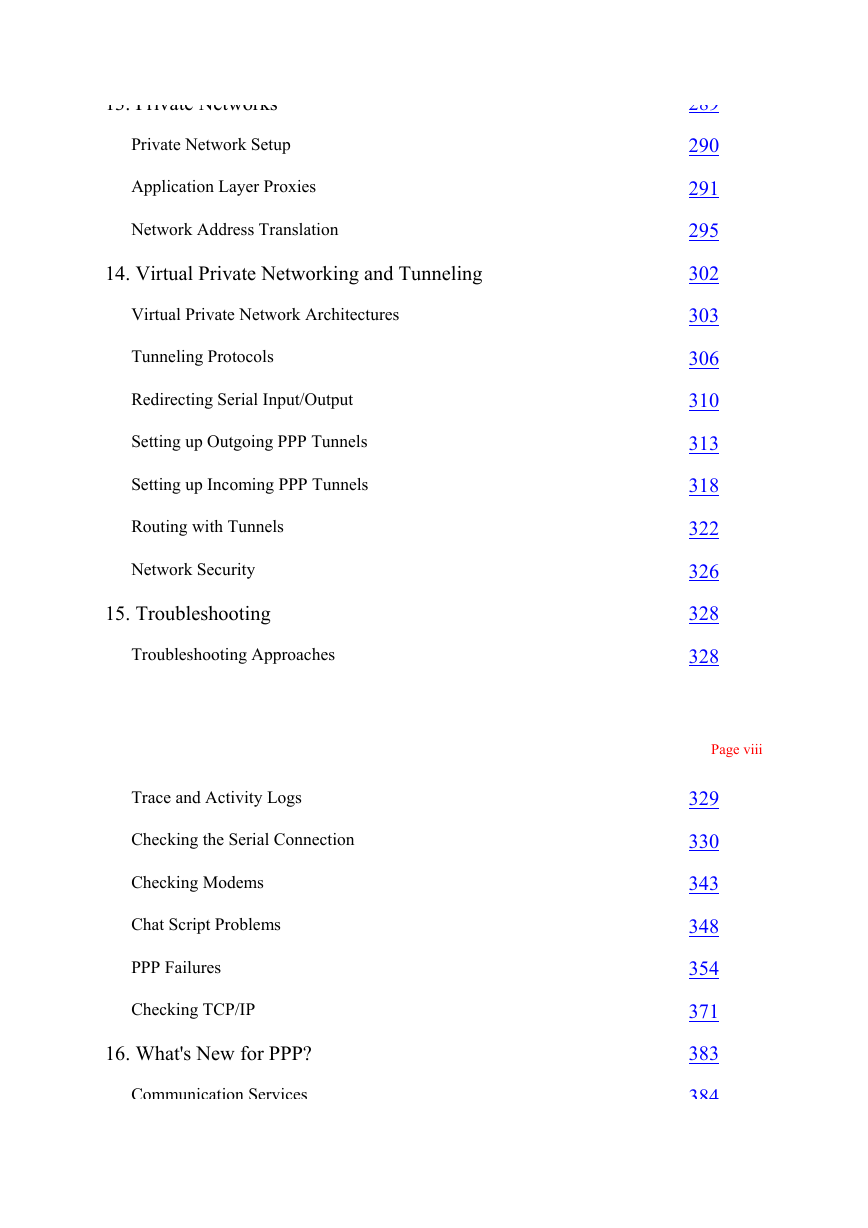
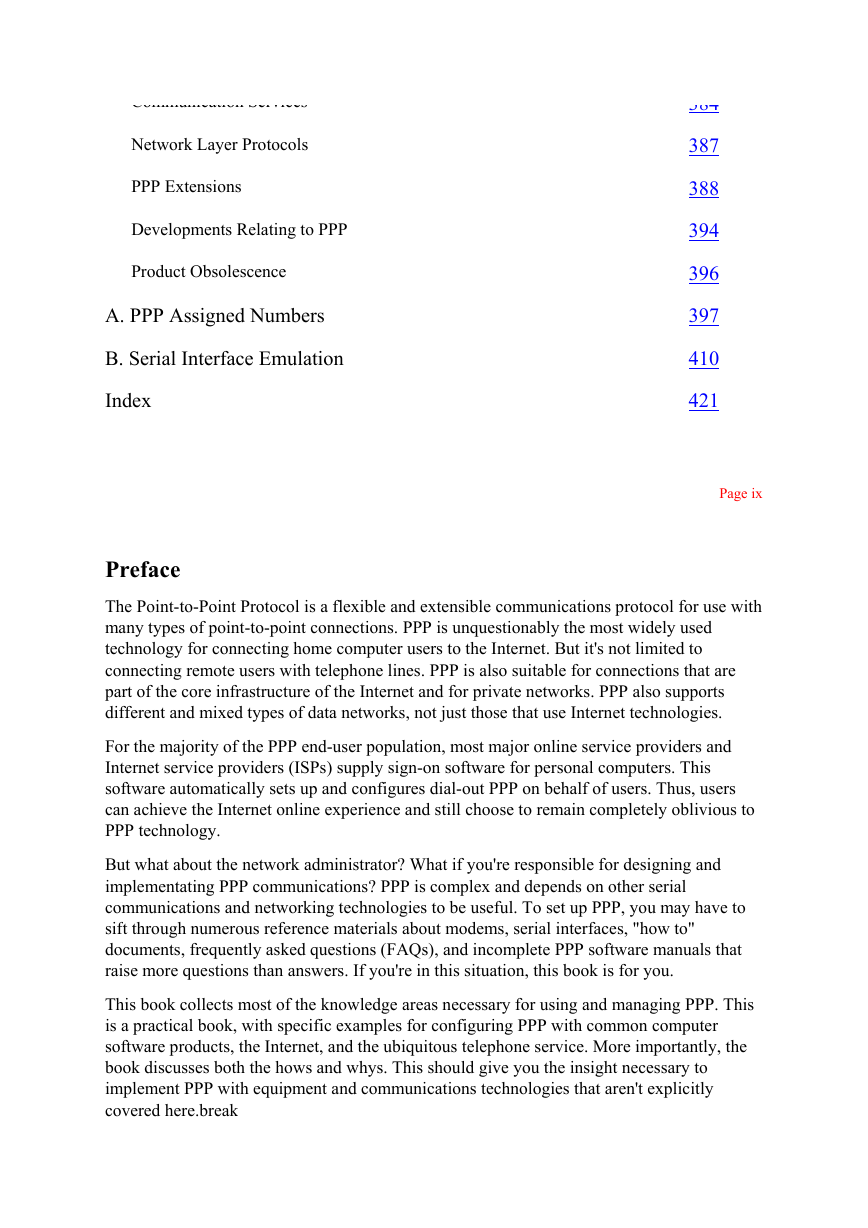
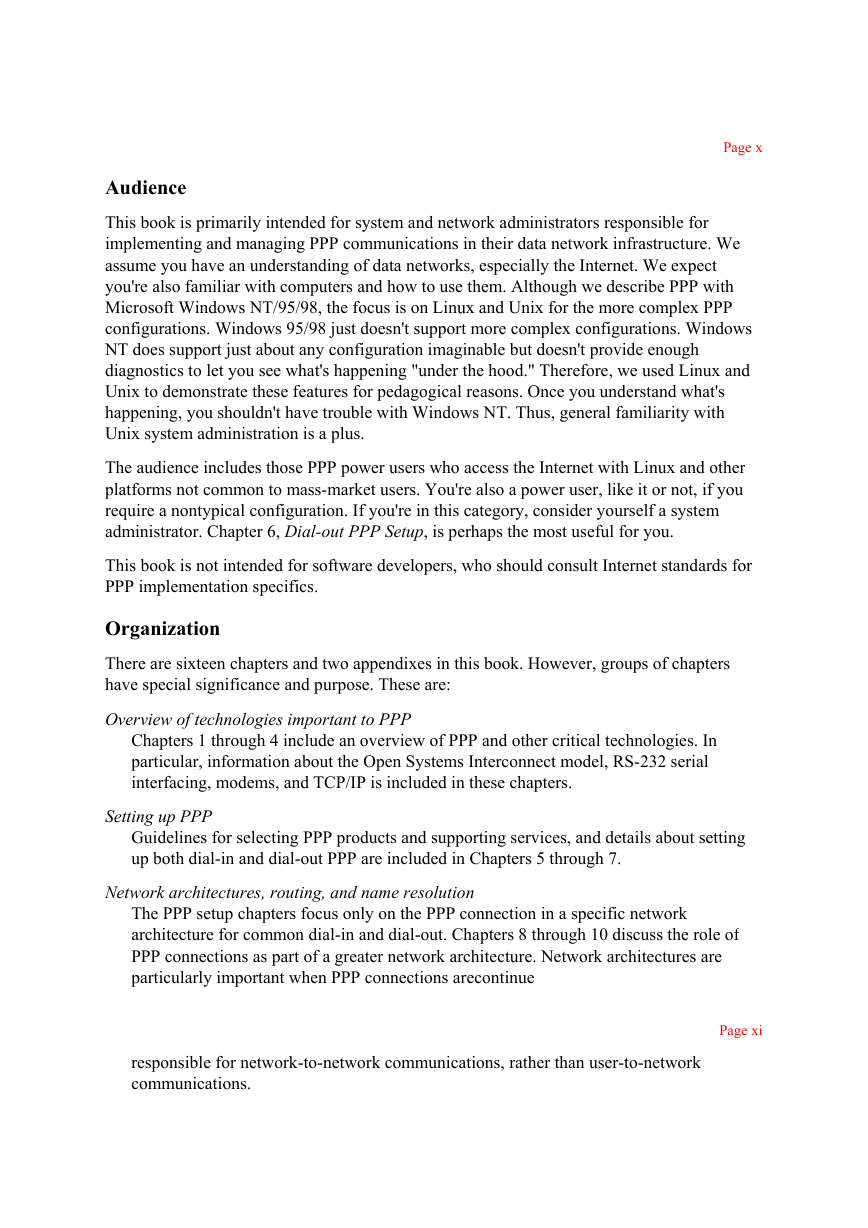








 2023年江西萍乡中考道德与法治真题及答案.doc
2023年江西萍乡中考道德与法治真题及答案.doc 2012年重庆南川中考生物真题及答案.doc
2012年重庆南川中考生物真题及答案.doc 2013年江西师范大学地理学综合及文艺理论基础考研真题.doc
2013年江西师范大学地理学综合及文艺理论基础考研真题.doc 2020年四川甘孜小升初语文真题及答案I卷.doc
2020年四川甘孜小升初语文真题及答案I卷.doc 2020年注册岩土工程师专业基础考试真题及答案.doc
2020年注册岩土工程师专业基础考试真题及答案.doc 2023-2024学年福建省厦门市九年级上学期数学月考试题及答案.doc
2023-2024学年福建省厦门市九年级上学期数学月考试题及答案.doc 2021-2022学年辽宁省沈阳市大东区九年级上学期语文期末试题及答案.doc
2021-2022学年辽宁省沈阳市大东区九年级上学期语文期末试题及答案.doc 2022-2023学年北京东城区初三第一学期物理期末试卷及答案.doc
2022-2023学年北京东城区初三第一学期物理期末试卷及答案.doc 2018上半年江西教师资格初中地理学科知识与教学能力真题及答案.doc
2018上半年江西教师资格初中地理学科知识与教学能力真题及答案.doc 2012年河北国家公务员申论考试真题及答案-省级.doc
2012年河北国家公务员申论考试真题及答案-省级.doc 2020-2021学年江苏省扬州市江都区邵樊片九年级上学期数学第一次质量检测试题及答案.doc
2020-2021学年江苏省扬州市江都区邵樊片九年级上学期数学第一次质量检测试题及答案.doc 2022下半年黑龙江教师资格证中学综合素质真题及答案.doc
2022下半年黑龙江教师资格证中学综合素质真题及答案.doc